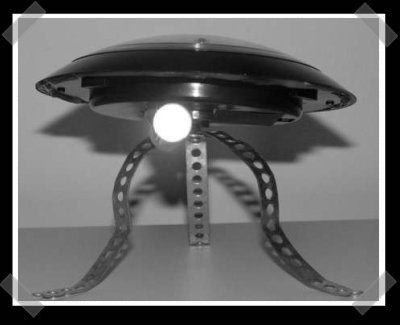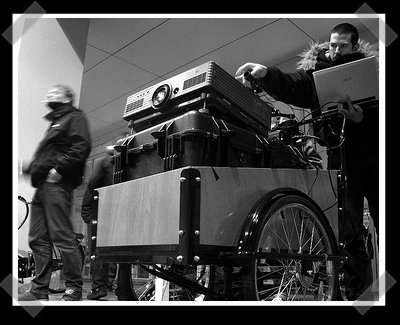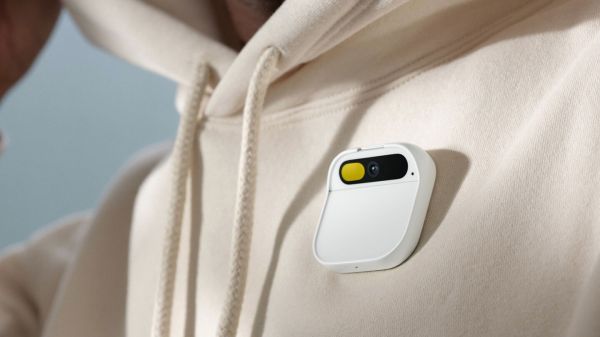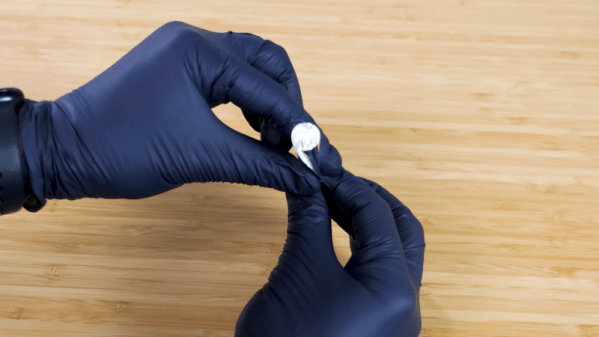[Sittiphol Phanvilai]’s multitouch screen project was posted a couple different places today. It uses the Nokia N95 to track light pens and draws the resulting paths on the video output. We immediately saw the applications for this in laser tagging. Right now if you want to do laser tagging you need to haul a laptop with you in addition to the projector. With some modification to the NeuScreen software you could replace the laptop with just cellphone plugged directly into the projector.
Solar Lamp To LED Projector

Despite the resemblance to an alien robot that might rebuild your house from scratch, this is actually the first mod for a solar yard lamp that I’ve seen. By adding a brighter LED, a couple of tubes, a laser printed transparency and a lens, you end with with a relatively inexpensive image projector that can project custom graphics from odd locations. [via]
Interactive Laser Drawing (graffiti)

This hack was linked a bit back in February, but it just didn’t get a decent write up. They used this 5000 lumen projector, a zoom lens video camera and a 60mw green laser pointer to generate interactive graffiti on nearby buildings. Most of the link love focused on the show-off video. I’m surprised that nobody mentioned the most obvious use: a laser pointer reactive white board. I could have loads of fun with this and my laptop during presentations. Thanks to [Brishen] for reminding me of this one.
Pentium Powered Extra With Friggin’ Lasers

[Neil] sent along this one and I found this one highly amusing. The latest use for recycling those old cpus: overvolt them a bit with a USB cable and keep your coffee cup warm. Use them as dressing for heat generating resistors.
[nik] came up with a non-destructive way to mount an external wi-fi antenna to his thinkpad. I like it, but I think you need a double height PCMCIA slot to fit it – Maybe a slimmer version could be built for a powerbook/macbook.
[Hybrid] found some interesting diy LASER projects. Including a $10 air laser. Sweet.
[joek1010] noted some interesting webcam laser hacks. The laser tracing webcam has definite possibilities.
[dualbandit] found a similar twist, but this time a laser pointer is used to remote control a mediacenter.
In case you’ve been following it, my DIY HD projector build on Engadget is finished up with the final review. I’m pleased with the image quality, but I’ll probably be tweaking the lamp/reflector assembly a bit.
Oh, and if you were into exploiting vending machines and getting free coke, it looks like they’ve pushed out a firmware patch.
Remember, only 11 more days to get your entry in for the Design Challenge. Just check out the prizes if you need motivation.
Hackaday Links: December 3, 2023
Sure, it does less than originally promised, but hey — at least it’s more expensive. That about sums up Tesla fans’ feelings after the long-awaited Cybertruck reveal at the Texas Gigafactory on Thursday, where Elon Musk himself handed over the keys — or their Cyber equivalent — to a few new owners. These are expensive machines — $61,000 for the two-motor model, and just shy of $100,000 for the three-motor all-wheel-drive model with all the bells and whistles. That’s considerably more than they were expected to cost back in 2019, a fact which may be at least partially behind the drop in Tesla shares after the launch.
The AI Pin: A Smart Body Camera That Wants To Compete With Smartphones
Seeking to shake up the smartphone market, Humane introduced its ‘AI Pin’, which at first glance looks like someone put a very stylish body camera on their chest. There’s no display, only the 13 MP camera and some other optics visible above what turns out to be a touch panel, which is its main gesture-based input method, while it’s affixed to one’s clothing using either a magnet on the other side of the fabric, a wireless powerbank or a clip. Inside the unit you find a Qualcomm octa-core processor with 4 GB of RAM and 32 GB of eMMC storage, running a custom Android-based ‘Cosmos’ OS.

There is also a monochrome (teal) 720p laser projector built-in that provides something of a screen experience, albeit with the expectation that you use your hand (or presumably any other suitable surface) to render it visible. From the PR video it is quite clear that visibility of the projection is highly variable, with much of the text often not remotely legible, or only after some squinting. The hand-based gestures to control the UI (tilting to indicate a direction, touching thumb & index finger together to confirm) are somewhat of a novelty, though this may get tiresome after a day.
An article by [Ron Amadeo] over at Ars Technica also takes a look at the device, where the lack of an app ecosystem is pointed out, as well as the need for a mandatory internet connection (via T-Mobile). Presumably this always-on ‘feature’ is where the ‘AI’ part comes in, as the device has some voice assistant functionality, which seems to rely heavily on remote servers. As a result, this ends up being a quirky device with no third-party app support for a price tag of $700 + the $25/month for online service. Not to mention that people may look a bit odd at you walking around with a body camera-like thing on your chest that you keep rubbing and holding your hand in front of.
To be fair, it’s not often that we see something more quaint in this space come out than Google Glass, now many years ago.
Dielectric Mirror Shines Bright
We knew the mirrors in our house were not really very good mirrors, optically speaking. Your mirror eats up 20 to 40 percent of the light that hits it. High-quality first-surface mirrors are better, but [Action Lab] has a video (see below) of something really different: a polymer dielectric mirror with 99.5% reflectivity. In addition, it has no Brewster angle — light that hits it from any angle will reflect.
Turns out something that thin and reflective can be hard to find. It also makes a little flashlight if you roll a tube of the material and pinch the back end together. The light that would have exited the rear of the tube now bounces around until it exits from the front, making it noticeably bright. The film comes from 3M, and apparently, they were surprised about the optical properties, too.














